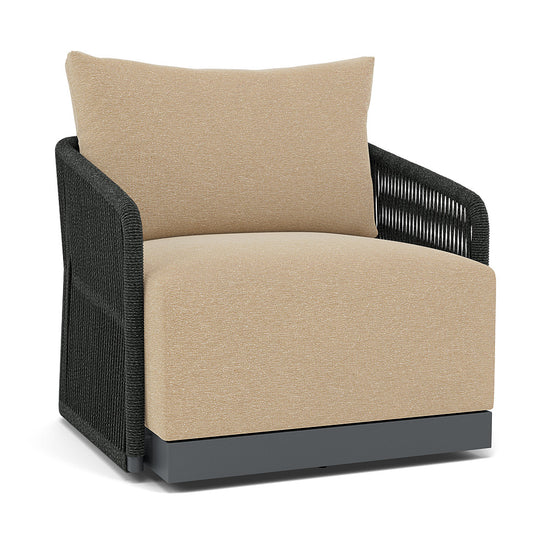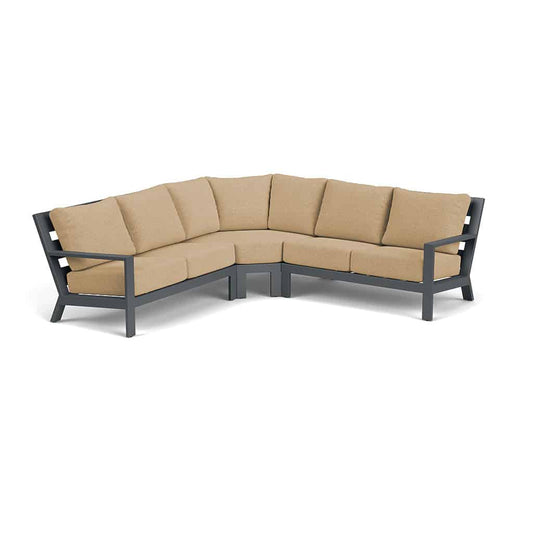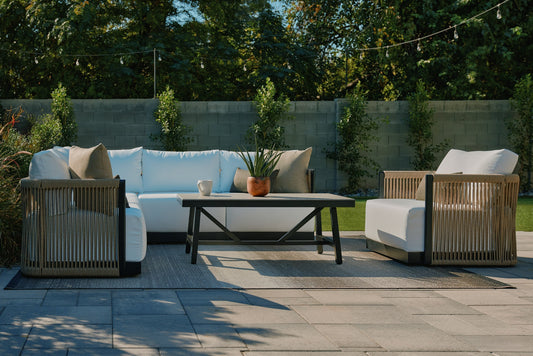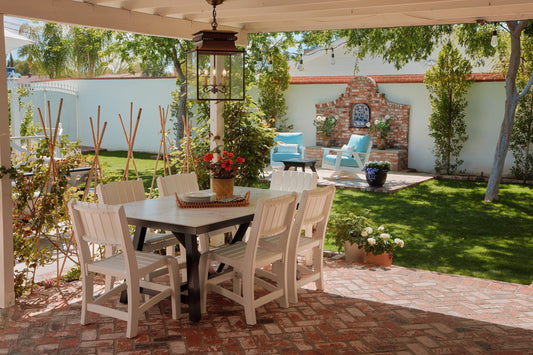Whether you're working with a compact courtyard, a side yard, or a large backyard patio, the layout is the foundation of great outdoor design. A smart layout not only makes your space more functional—it sets the tone for how you live, relax, and entertain outside. Below are five layout ideas, complete with practical takeaways and inspiration drawn from real patio setups.
1. Use Rugs to Anchor and Define Each Zone
In outdoor design, rugs do more than add color and texture—they visually define your space. This is especially helpful on larger patios where furniture might otherwise feel like it’s floating. Placing a rug under your seating group instantly frames it and signals that this is a designated gathering area.
Pro tip: Round coffee tables can feel a bit lost if the surrounding seating is too linear. Try angling two chairs inward to make the shape feel purposeful. Add a fire table—like our 54” Bliss Fire Table—and you’ve created a conversation zone that feels intentional and complete.

2. Think Beyond the Sectional
A common go-to for big patios is the outdoor sectional—but it’s not always the most flexible option. Instead, think modular: Try using three sofas to create a U-shape. This mimics the comfort and intimacy of a sectional but gives you more freedom with spacing, traffic flow, and rearrangement.
Why it works: Unlike a sectional, which often has a corner seat that’s underused, three separate sofas make each spot feel like the “best seat in the house.” This setup is great for hosting larger groups without making anyone feel stuck in a corner.
3. Keep Seating and Dining Close—But Create Visual Separation
When your space needs to accommodate both lounging and dining, the key is separation without division. These two zones can live side by side while still feeling distinct.
Design tip: Use a narrow sofa table—like the Asheville Storage Cart—as a divider between your seating group and dining set. It visually separates the areas while maintaining an open feel. Bonus: It offers functional storage or a serving surface during gatherings.
Rugs help here, too. Use one under the seating area and leave the dining set on the exposed patio—this contrast keeps each area feeling anchored but distinct.
![]()

4. Mix and Match Materials for a More Curated Look
Gone are the days of matchy-matchy patio sets. Some of the most stylish outdoor spaces today mix different materials—think aluminum with wicker, rope with wood tones, or EcoLumber with powder-coated metals. When done thoughtfully, combining collections can create a more layered, intentional look that feels polished and personal.
Here’s how to make it work:
-
Aluminum + Wicker: Use powder-coated aluminum seating (like our Newport or Peninsula collections) with resin wicker dining chairs (like those from our Loire Valley collection) for a mix of smooth and textured finishes. The sleek aluminum brings structure, while the wicker adds a relaxed, beach vibe.
-
Rope + EcoLumber: Rope-wrapped chairs from our Resort or Villa collections pair beautifully with EcoLumber pieces from our Patriot, Frame & Asheville collections. The rope adds warmth and visual interest, while the EcoLumber brings a solid, wood-like presence—and both materials are durable and low-maintenance.
-
Aluminum + Rope: Mixing a powder-coated aluminum dining set with rope-accented lounge furniture gives you clean lines and soft detailing in the same space. Keep the frame finishes complementary, and let the materials do the talking.
Keep it cohesive: Choose collections with shared color tones in the frames or fabric to create visual harmony. For example, a graphite aluminum frame and a neutral-toned rope detail won’t feel mismatched—they’ll feel sensible. You can also tie everything together with shared accessories, like matching cushions, throw pillows, planters, or rugs.
Why it works: Mixing materials gives your patio a layered, lived-in feel—like a room that’s been thoughtfully collected over time, not bought all at once. It also gives you more flexibility to choose the pieces that best fit each function—lounging, dining, or entertaining.
5. Break the Grid—Use Angles to Soften Your Space
Patio layouts can easily become boxy or overly symmetrical. Playing with angles introduces movement and softness. Angled chairs or slightly rotated groupings invite people in and encourage conversation.
Try this: Instead of placing all your furniture square to the house, experiment with setting a pair of chairs at a slight angle to a sofa or fire table. This creates a more dynamic flow and opens up the space visually. It’s especially helpful when working with round or oval tables that benefit from a less rigid approach.

Ready to Create Your Perfect Layout?
At the end of the day, the best patio layout is one that fits your space, your lifestyle, and how you love to spend time outdoors. Whether you’re mixing materials, defining zones, or reimagining how seating and dining can flow together, designing the right setup makes all the difference.
 Need help visualizing what works best for your patio? Stop by one of our showrooms to see real-life layouts in person. You’ll be able to feel the materials, test the spacing, and get expert guidance from our Exterior Design Guides to bring your vision to life.
Need help visualizing what works best for your patio? Stop by one of our showrooms to see real-life layouts in person. You’ll be able to feel the materials, test the spacing, and get expert guidance from our Exterior Design Guides to bring your vision to life.
Some visuals in this post were created using AI-based image generation tools.













